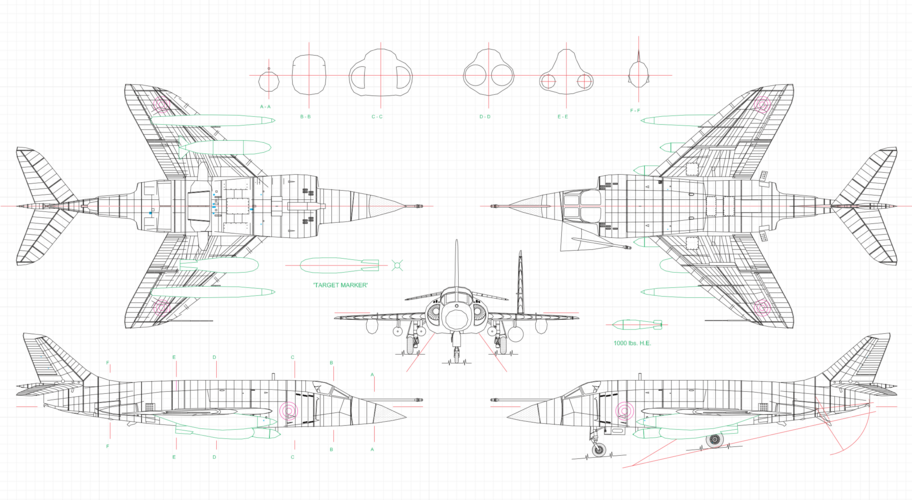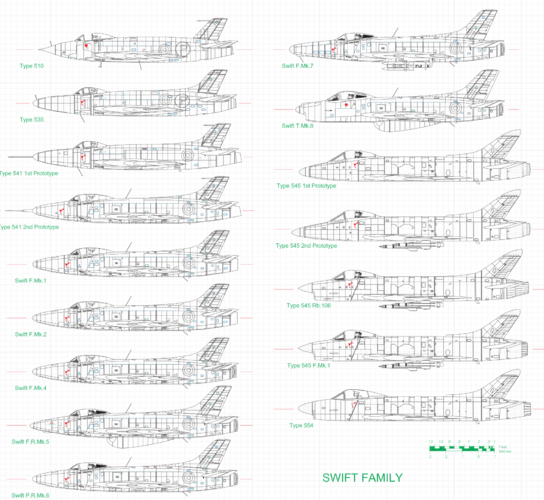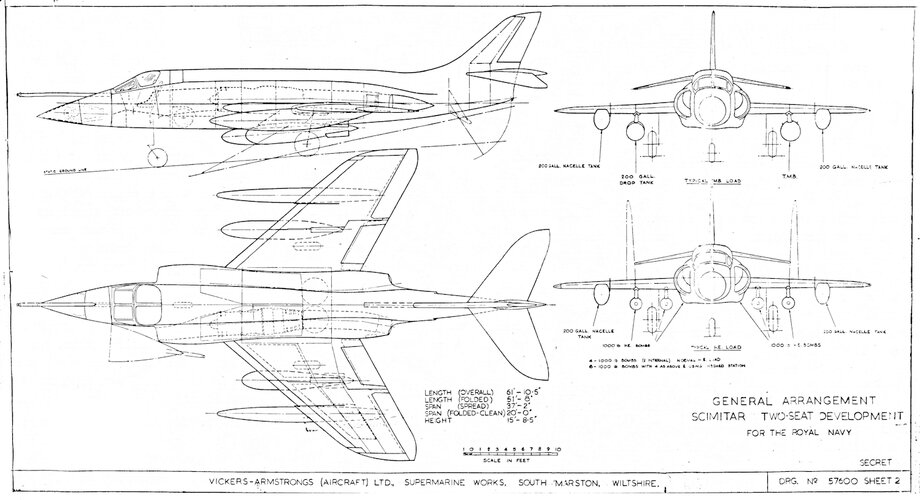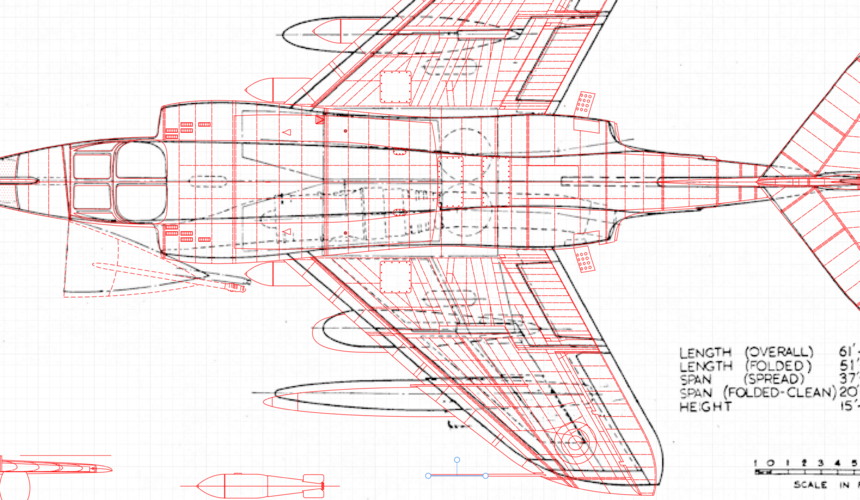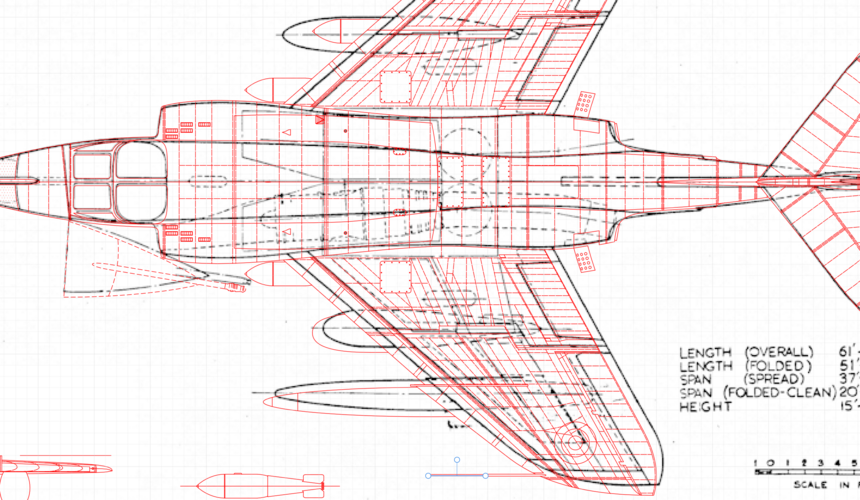Some Swift moans from the files (its worth noting that Hawker had their own problems and got it in the neck just as much over delays in fixing problems, luckily for them the Hunter seemed to come right in the end, the Swift just seemed never to improve enough and in the end was canned and should probably never have been begun without a proper OR and rational design rather than the knee-jerk reactions to MiGs over Korea).
Minute 7/Acft/11950 ‘Swift F.Mk.2 – Conditions of Release to the Service’ by R.D.L.4 L. Johnston to D.O.R.1, 3/6/54
Vickers are investigating various means of removing the tendency to tighten in turns. Some of these are easy changes and others such as the dropped leading edge and faired tooth are more difficult to apply.
A Mk/2 aircraft with c.g. move forward, improved tensioning in the elevator circuit, modified stick-elevator gearing and elevator tab movement has been flown by the firm. They consider that in this condition the aircraft characteristics are much the same as the Mk.1 and if agreed by AAEE a C.A. Release on the same terms as for the Swift Mk1 could be given.
Time for wing mods cannot be estimated nor for retrospective fitting.
Loose Minute to P.S. of S. of S., undated but after 14/4/54
Turning Circle – variable incidence tail will improve the turning circle a little. More importance contributions to a reduction in the turning circle are the application of re-heat and a flying tail…Mk.4 to have reheat and variable incidence tail… not able to say when flying tail will be introduced… the turning circle of the Mark 4 Swift with re-heat unlit is likely to be even greater than that of the Mark 1.
Turn Round Time – The Swift started life as a P.V. and made the minimum allowance for radio equipment; it has since proved difficult to provide a really satisfactory radio layout. At present it takes up to 1.5 hours to change the second V.H.F. set; however, for this particular equipment an alternative position has now been found…Access to the engine starting equipment will be improved in the Swift Mark 3 and later Marks.
Aerial System – The present system was the best that could be provided if the aircraft was not to be further delayed. An improved external aerial should be ready for test shortly. Supressed aerial may follow later but firm’s proposal for canopy aerial incompatible with canopy de-icing.
Improved Vision – Improved canopy discussed and approved by M.C.S., firm, Fighter Command and D.O.S. in August 1952 will be introduced on Mk.4. Ejector seats better than US ones (fully automatic) but do block some rear view.
Over-spill of fuel – This is caused by faulty design in the vent pipe system. A modification is being introduced to raise the level… of the vent pipe.
Hunter prepared to an O.R. and should be better in regards to servicing.
Now reasonably confident that by early June a C.A. release will be forthcoming and at the same time Hunters with essential modifications incorporated will be available in quantity.
Hunter will be more manoeuvrable but suffers from same aerial problem, firms lack experience on this subject.
Loose Minute ‘Trial of the Swift No.1 at C.F.E.’ by A/A.C.A.S. (Ops.) Air Commodore K.B.B. Cross to DCAS, 19/3/54
ACAS(OR)’s minute of 15/3/54 does not accentuate sufficiently the shortcomings of the Swift, especially when compared to Sabre (in service 5 years and Swift planned in service until 1959/60).
CFE are thoroughly disappointed with the elevator control… Above Mach 0.9 the elevator becomes progressively less effective as height is increased, and at 40,000ft the stick can be moved as much as 4in fore and aft without response… becomes acute when the airbrakes are operated in dives at high Mach numbers. Under these conditions the elevators are totally ineffective until the air brakes are retracted again… not satisfied a variable incidence tail will make improvements in combat handling due to use of tail trimmer throughout diving attack… Is not the proper answer to press for a fully flying tail and an improved power control system?
Engine surging and compressor stalls not dangerous in normal flying… but are totally unacceptable under combat conditions, and remedial action must be taken urgently.
The present limitations make the Swift a poor combat aircraft even in the limited role of bomber destroyer. In the fighter v. fighter role, which the Swift will certainly have to undertake in 2nd T.A.F, if not in the U.K., these failings do not give it even a fighting chance in combat.
Loose Minute Swift Acceptance Conference by Wing Commander H.J. Cundall to D.O.R.(A), 19/11/54
Boscombe Down stand firmly by their opinion that, while the handling characteristics of the Swifts have greatly improved, the Marks 3 and 4 are still not in a condition to permit release to the Operational Command. Turn tightening largely removed but elevator effectiveness at speeds above M0.96 not yet satisfactory. Limits easily reached at M0.9 at max level speed without reheat.
By using the V.I tail trimmer as a flying control, in some conditions serious turn tightening can be induced, Ineffectiveness of elevators encourages greater use of the V.I. tail, restrictions might not be observed in service conditions.
Flying qualities of Mark 3 nearer acceptable release standard due to larger elevators lacking from Mk.4 due to V.I. tail.
Further boosting on Mark 3 may suffice and a simple modification expected to be available for Boscombe Down trials within a week or so. Report in December. Mark 4 more extensive, redesign of the elevator and greater power boosting or early introduction of full flying tail. Unofficial estimate of effective delay to delivery is three months.
Shock to hear despite their high priority requests for flying tail, the firm has a low priority. A clause from the contract was quoted from memory by the production representatives of the firm calling for development of the flying tail with “the least possible expenditure of public money”. DMARD astonished and undertook to get contract amended. Firm estimated the flying tail may fly before end of December with raised priority.
Loose Minute Swift Aircraft – Pilot Ejection by Sqn Ldr D.R. Kingaby Ops.(A.D.)1, 23/11/54
In Swift Fortnightly Narrative Report No.2 dated 8/11/54, stated pilots of above average height or body length are unfavourably placed for ejection, cannot safely raise arms to the ejection blind without their elbows entering the slipstream. Removing the exposure suit from the set pack necessary. Only regarded as an interim measure, request to investigate methods to ensure safe ejection.
Loose Minute Swift Strength Factors by Gp Capt H.N.G. Wheeler D.D.O.R.1 to A.D/R.D.L.1 12/11/54
Modification No.237 recently considered by the A.M.C. Strengthens fuselage at the wing spar attachment and between frames 31 and 33, will be embodied in 87th aircraft onwards, probable weight restrictions on unmodified Mk.2 & 4 aircraft.
Committee ruled this situation unacceptable, asked firm to state the production delay involved in bringing embodiment forward to first Mk.4 aircraft and the nature of the weight restriction.
Case only part of general strength factors. Previously wrote 25/7/54 on this issue and wants further advice.
Unwilling to accept any Swifts with restrictions on them. Should apply mods before service release and if not able to, should make mod applicable retrospectively.
Minute Swift – Variable Re-heat by H.G. Knight Eng.R.D.2. to R.D.L.4, 14/10/54
Further to loose minute to O.R.1(b) 27/9/54, Rolls-Royce suggest not long before variable reheat can be cleared, action should now be initiated to apply modifications to throttle control.
Modification is mainly embodying micro-switches in such a manner that a certain amount of adjustment in position is possible.
Minute Swift – Variable Re-heat by H.G. Knight Eng.R.D.2. to R.D.L.4, 27/9/54
Reply to loose minute 30/8/54, bench and flight tests at Rolls-Royce underway. Two difficulties have arisen which need a certain amount of redesign.
A considerable change in RPM at a given throttle setting occurs with change of altitude, under certain conditions the whole control systems becomes unstable.
Probably 3-6 months before recommending a scheme for service use.
Minute Swift – Flying Tail by DMARD(RAF) to D.O.R.(A) 24/9/54
Response to minute 1/9/54, we raised the question of a flying tail nearly a year ago, firm prepared a scheme and a contract was placed last March for a trial installation.
Should be ready for flight trials before the end of the year.
Considering advisability of putting tail into production aircraft without waiting for test results, will recommend this if risk is reasonable. Retrospective fit feasible if aircraft returned to works.
We see no grounds for rejecting Swift with V.I. tail, should be broadly similar to Hunter 1 & 2 but has advantage of extra fuel and reheat.
[Handwritten note at bottom by DOR(A) to DDOR1 “No immediate action on this pending the outcome of own recommendation on the future of the Swift + also the Boscombe trials with the VI tail BF in one month”]

